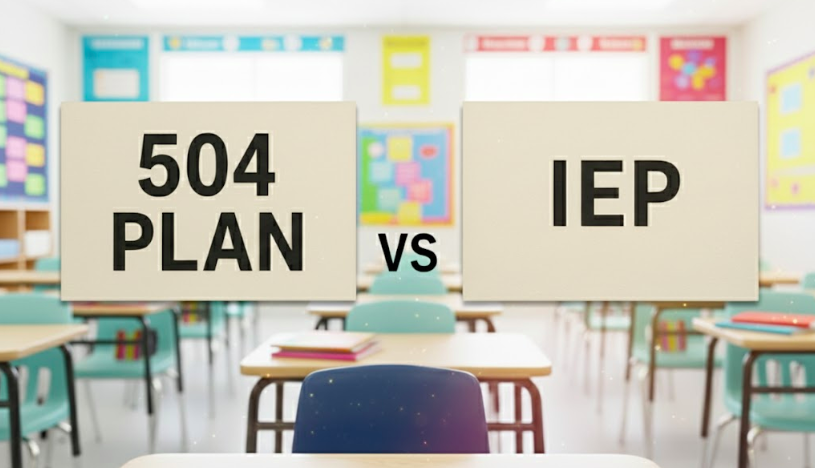504 Plan vs. IEP: Key Differences and When to Use

Key Takeaways
- 504s and IEPs help over 7 million students in the United States participate meaningfully and appropriately in classrooms with their peers.
- Educators have both professional and legal obligations to create these plans, and it’s essential to understand when and how each should be used.
- Professional development is a key component for keeping the workforce informed and empowered to serve students with disabilities.
Classrooms are more inclusive than ever, and roughly 15% of all public school students benefit from educational accommodations and thoughtful classroom structure. With a well-constructed IEP or 504 plan, 7.5 million young people in America with physical disabilities, Autism Spectrum Disorder (ASD), ADHD, and a wide range of other conditions are empowered to participate in regular classroom activities with their peers.
IEPs are some of the most common tools educators use to optimize a student’s learning environment, and 504s also play a critical role. But which one is appropriate for any given child? Both are mandated by state and federal law, so teachers and administrators need to have a thorough understanding of why and how each plan is used.
Professional development courses like Understanding and Implementing Section 504 Plans: Ensuring Equity and Access for All Students provide a solid foundation for creating and implementing a 504 plan vs. IEP. Here’s an overview of both and the contributing factors to consider when selecting one.
What are 504 Plans?
504s are named after Section 504 of the federal Rehabilitation Act of 1973. The purpose of Section 504 is to prevent discrimination against individuals with disabilities in schools and other programs that receive federal funding.
504s outline the accommodations a school will be legally obligated to provide to help a student with a disability so they can learn alongside their peers. However, they do not alter the core curriculum or grading criteria—a key distinction from IEPs.
Example accommodations might include:
- Extended time on tests and assignments for a student with a processing disorder.
- Access to assistive technology to support an auditory disability.
- Modified classroom materials for a visually impaired child.
- Permission to take breaks during class for students with ASD.
Note that these adjustments remove barriers to learning but do not fundamentally change the nature, scope, or proficiency required by the core curriculum. Also, 504s can be simple documents, detailing minor but valuable accommodations such as accessible seating.
What Is an IEP?
Individualized Education Programs (IEPs) are governed by the Individuals with Disabilities Education Act (IDEA), a federal law that outlines the obligations schools have to students with disabilities and their families.
A child may be eligible for an IEP if their disability will significantly impact their ability to keep pace with the core curriculum. They are typically created by education professionals in consultation with parents and specialists to identify both accommodations and curriculum adjustments that reflect reasonable milestones a student can be expected to achieve.
IEPs go beyond 504s to include considerations such as:
- Current academic and functional performance
- Annual, measurable goals
- Progress monitoring and reporting
- Transition planning (for students 16 and older)
As such, IEPs are more robust, comprehensive documents than 504s that demand close coordination between education professionals, families, and specialists. It’s important to note that a child who qualifies for an IEP also meets the threshold for a 504, and a careful consideration of their specific needs may be required to differentiate between a 504 plan vs. IEP.
504 Plan vs. IEP: A Comprehensive Breakdown
Because creating, maintaining, and reviewing 504s and IEPs are directly related to a student’s civil rights, educators have both an educational and a legal obligation to thoroughly understand these plans. The following head-to-head comparison covers the major differences between them.
Governing Law
- 504 Plan: Section 504 of the Rehabilitation Act (Civil Rights Law)
- IEP: Individuals with Disabilities Education Act (IDEA) (Education Law)
Purpose
- 504 Plan: Provides equal access to the core curriculum through accommodations
- IEP: Outlines specialized instruction, accommodations, and curricular adaptations to meet appropriate educational goals
Eligibility
- 504 Plan: Any disability that substantially limits one or more major life activities
- IEP: One of 13 IDEA disability categories and a need for special education
Services Provided
- 504 Plan: Accommodations and modifications (e.g., testing adjustments, classroom supports)
- IEP: Specialized instruction, accommodations, modifications, and related services (e.g., speech therapy, occupational therapy)
Documentation
- 504 Plan: Written plan outlining accommodations, including specific obligations and implementation roles
- IEP: Detailed legal document created by specialists, education professionals, and parents, including goals, services, progress monitoring, and individual rights
Evaluation Process
- 504 Plan: Less formal; can rely on school records, teacher input, and medical documentation
- IEP: Comprehensive, formal evaluation by a multidisciplinary team
Review Frequency
- 504 Plan: Less formal; can rely on school records, teacher input, and medical documentation
- IEP: Reviewed at least annually; full reevaluation every three years
Parental Involvement
- 504 Plan: Parents are encouraged to participate but not required
- IEP: Parents are integral members of the IEP team and must consent to evaluations and services
Enforcement
- 504 Plan: Overseen by the Office for Civil Rights (OCR)
- IEP: Overseen by state education agencies and the U.S. Department of Education
Can a Student Have Both?
A student will have either a 504 Plan or an IEP, not both. If the student qualifies for an IEP, that plan already includes accommodations similar to those in a 504 Plan. The IEP is more comprehensive and automatically fulfills Section 504 protections.
Getting a 504 Plan vs. IEP Right for All Your Students
In today’s inclusive classrooms, educators will come into contact with 504s and IEPs on a daily basis in their work. It’s vital to know your obligations, when each should be used, and how to take an active role in carrying them out.
Professional development is essential for creating 504s and IEPs, and Premiere is committed to ensuring educators have access to high-quality, comprehensive resources for when to use a 504 plan vs. IEP. Courses like Understanding and Implementing Section 504 Plans: Ensuring Equity and Access for All Students and The Art of Writing Quality IEPs: Best Practices for Educators empower education professionals to create effective plans and advocate for their students with disabilities.
All of Premiere’s courses are developed by experts in their field and make it easy for busy educators to meet their legal and professional obligations while building their careers.
FAQs
What can an IEP do that a 504 can't?
504s are appropriate when a student needs classroom accommodations to be successful but doesn’t require alterations to the core curriculum. An IEP is a more comprehensive document that includes curriculum adjustments, individualized goals, and evaluation criteria in addition to 504 accommodations.
Should ADHD be a 504 or IEP?
A student with ADHD may qualify for both a 504 and an IEP depending on their unique circumstances. Education professionals will need to consult with specialists and family members to determine which one is appropriate.
What role do parents play in 504 plans?
Whereas parents have legally defined roles and rights in the creation of an IEP, they are not legally obligated to participate in creating a 504. However, school officials should encourage parents to contribute their perspectives and insights to develop a 504 that best meets a student’s needs.
Latest Posts


.png)



